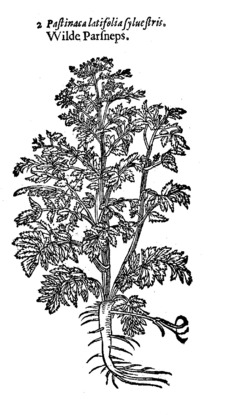The stereotype of British cookery as nothing more than meat and potatoes post-dates the manuscript recipe books that I’ve been cooking from over the past six years. Potatoes are an American vegetable. They slowly rose to prominence in a cuisine that already made good use of many other root vegetables.
The staple root vegetables of British cookery in the medieval period through the Renaissance were parsnips, carrots, turnips, and skirret. Parsnips are starchy and slightly sweet with a uniquely herbaceous flavor. John Gerard’s Herbal (1597) describes both garden and wild varieties as well as offering advice on cultivation, consumption, and humoral properties.


I love parsnips. Needless to say, I was thrilled when I saw a recipe for “Parsnip Cakes to Fry” in Margarett Greene’s recipe book (f MS.1980.004), dated 1701, now held in the Clark Library collections. Somewhere between a starchy pancake and a fritter, these make a wonderful side for any roast dinner or hearty vegetarian meal.
The Recipe
Parsnip Cakes to Fry.
Take Parsnips Boyle them tender peil them & rub them through a
Seive whilst thay are hott. then take halfe a pinte of Creame & –
as much new milke, the yealkes of 6 Eggs & the whites of 3 make this as
[t]hick as a pudding. with a Spoonefull of Flower & the parsnips Season
it with Salt Sugar, & Beaten Nutmeg & Sack to your tast. froy them
with [B]oyleing hott Butter. Serve them with Butter Sack & Sugar./
 The recipe describes a cooking method of boiling the parsnips with their skins on, peeling them, and using a sieve to break them down that is well suited to contemporary kitchen equipment. Parsnip skins can easily be removed with a knife after cooking with less loss of vegetable matter. Pushing cooked parsnips through a sieve creates a fine mash. I peeled and chopped the parsnips before I boiled them (because modern vegetable peelers are excellent) and mashed them with a potato masher.
The recipe describes a cooking method of boiling the parsnips with their skins on, peeling them, and using a sieve to break them down that is well suited to contemporary kitchen equipment. Parsnip skins can easily be removed with a knife after cooking with less loss of vegetable matter. Pushing cooked parsnips through a sieve creates a fine mash. I peeled and chopped the parsnips before I boiled them (because modern vegetable peelers are excellent) and mashed them with a potato masher.
Updated Recipe
Halved from the original. Makes approximately 14 cakes.
7 parsnips (about 1.5 lbs)
1/2 t salt
1/2 t sugar
1/8 t nutmeg (grated or ground)
1 t sack (sherry)
1 1/2 t flour
2 eggs
1 egg yolk
1/2 c whole milk
1/2 c heavy cream
about 3 T butter for frying
Peel the parsnips and cut them into small pieces (approximately 1 inch).
Put them in a pot filled with water and bring it to a boil. Reduce to a low simmer and boil for about 20 minutes (until parsnips are tender and easily pierced with a fork).
Drain parsnips and put them in a large mixing bowl.
Mash the parsnips until they have a regular consistency with no large chunks. Season this mash with salt, sugar, nutmeg, and sack. Add the flour and eggs. Finally, pour in the milk and cream and stir until a slightly chunky batter forms.
Heat a cast iron skillet or large frying pan.
Add butter to the skillet and lower the heat to medium. Use a 1/4 cup measure to pour cakes into the pan. (I could fit four cakes at a time in my twelve-inch cast-iron skillet.) Cook for 3 minutes on the first side and 2 minutes on the second side. The fritters should be golden brown and slightly crispy. Repeat this process until you have cooked all your batter. Make sure the pan is still buttery before you start each batch.
Serve hot.
The Results
Buttery, fluffy, and lightly scented with nutmeg, these parsnip cakes are delicious. Although I would serve them with savory dishes, they are sweet and could easily be treated more as a desert if I’d served them with sugar and sack (sherry) as the original recipe instructed. The combination of flavors speaks to a common way of eating in the seventeenth and eighteenth centuries where sweet and savory dishes were not divided into separate courses. (I touched on this in my recent post about a recipe for Portugal Eggs).
The next time I make these, I might add a bit more flour or start with another parsnip or two to create a stiffer mixture. The cakes were prone to collapse during flipping and required careful handling with a spatula.
Finally, although these parsnip cakes are at their best immediately after making them, you can reheat them if you’ve prepared them in advance of a holiday meal or made more than you can eat in one sitting. Deb Perelman recommends reheating previously fried cakes on a baking sheet in a 325F oven before serving on her site Smitten Kitchen (where you will find many wonderful modern fritter recipes).






Hey Riss-These sound wonderful. Dad
Sent from my iPhone
>
Thanks, Dad!
1 1/2 t flour or 1 1/2 c flour? t seems like so little flour 😮